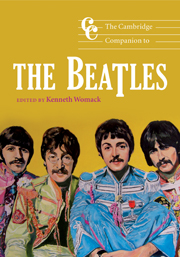Book contents
- Frontmatter
- Introducing the Beatles
- Part I Background
- Part II Works
- 3 Rock and roll music
- 4 “Try thinking more”: Rubber Soul and the Beatles' transformation of pop
- 5 Magical mystery tours, and other trips: yellow submarines, newspaper taxis, and the Beatles' psychedelic years
- 6 Revolution
- 7 On their way home: the Beatles in 1969 and 1970
- 8 Apple Records
- 9 The solo years
- 10 Any time at all: the Beatles' free phrase rhythms
- Part III History and influence
- Notes
- Beatles discography, 1962–1970
- Select bibliography
- Index
9 - The solo years
from Part II - Works
Published online by Cambridge University Press: 28 September 2011
- Frontmatter
- Introducing the Beatles
- Part I Background
- Part II Works
- 3 Rock and roll music
- 4 “Try thinking more”: Rubber Soul and the Beatles' transformation of pop
- 5 Magical mystery tours, and other trips: yellow submarines, newspaper taxis, and the Beatles' psychedelic years
- 6 Revolution
- 7 On their way home: the Beatles in 1969 and 1970
- 8 Apple Records
- 9 The solo years
- 10 Any time at all: the Beatles' free phrase rhythms
- Part III History and influence
- Notes
- Beatles discography, 1962–1970
- Select bibliography
- Index
Summary
On December 31, 1970, Paul McCartney brought suit to end his partnership with the other three Beatles, making official what had already in fact happened. The four lovable moptops turned countercultural icons had ceased to function as a cohesive unit by the time of The Beatles (the White Album, 1968), with Abbey Road (1969) pulling them together only as one last defiant act against the dissolution embodied in Let It Be. And so “John, Paul, George, and Ringo,” for the first time in their adult lives, faced a future as something other than Beatles. These four young men, four Beatles alone but inextricably bound to one another, would spend the next months and years alternately shunning and embracing their storied past. Three ex-Beatles – all but Lennon, who was murdered on December 8, 1980, at the age of forty years – would continue to grapple with their pasts as they entered middle age and beyond. This chapter provides a broad overview of the post-Beatle lives and careers of Lennon, McCartney, Harrison, and Starr, and considers their evolution as individual artists.
As it had been at the time of the Beatles' arrival on US shores in 1964, success in America was the “golden ring” of the entertainment industry in 1970, and was the biggest guarantor of success elsewhere. Hence, though occasionally referring to the British context and sources, the focus here is on the artistic evolution of the four ex-Beatles within the context of their reception by American critics and audiences. This chapter, alone in this book, is not about the Beatles. My purpose here is to answer the same question faced by Lennon, McCartney, Harrison, and Starr, not only in 1970, but for the rest of their lives, namely: what does it mean to not be a Beatle? This question reverberated in the lives of the solo Beatles. They were stars of the first order, and they – and their audience(s) – had to contend with the band’s highly developed image, one bound up in the imaginations of a significant portion of baby-boomers.
- Type
- Chapter
- Information
- The Cambridge Companion to the Beatles , pp. 153 - 182Publisher: Cambridge University PressPrint publication year: 2009
- 1
- Cited by

